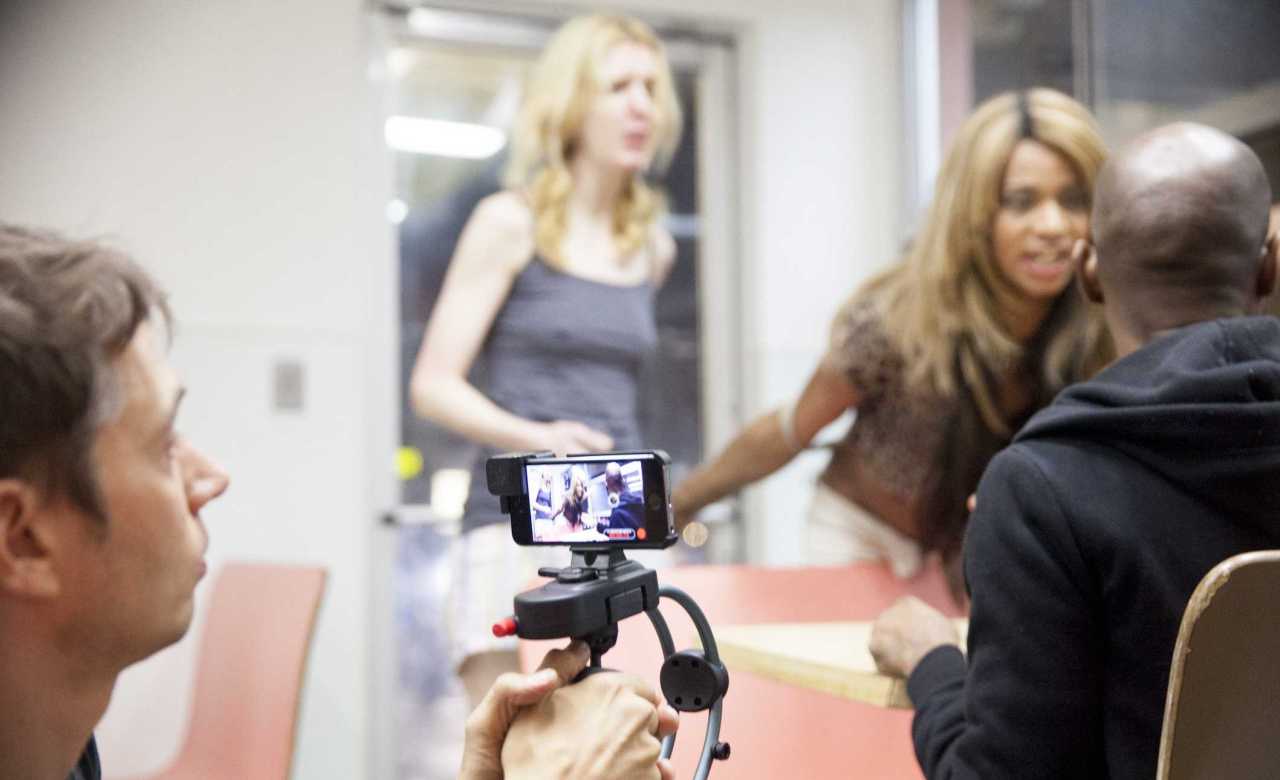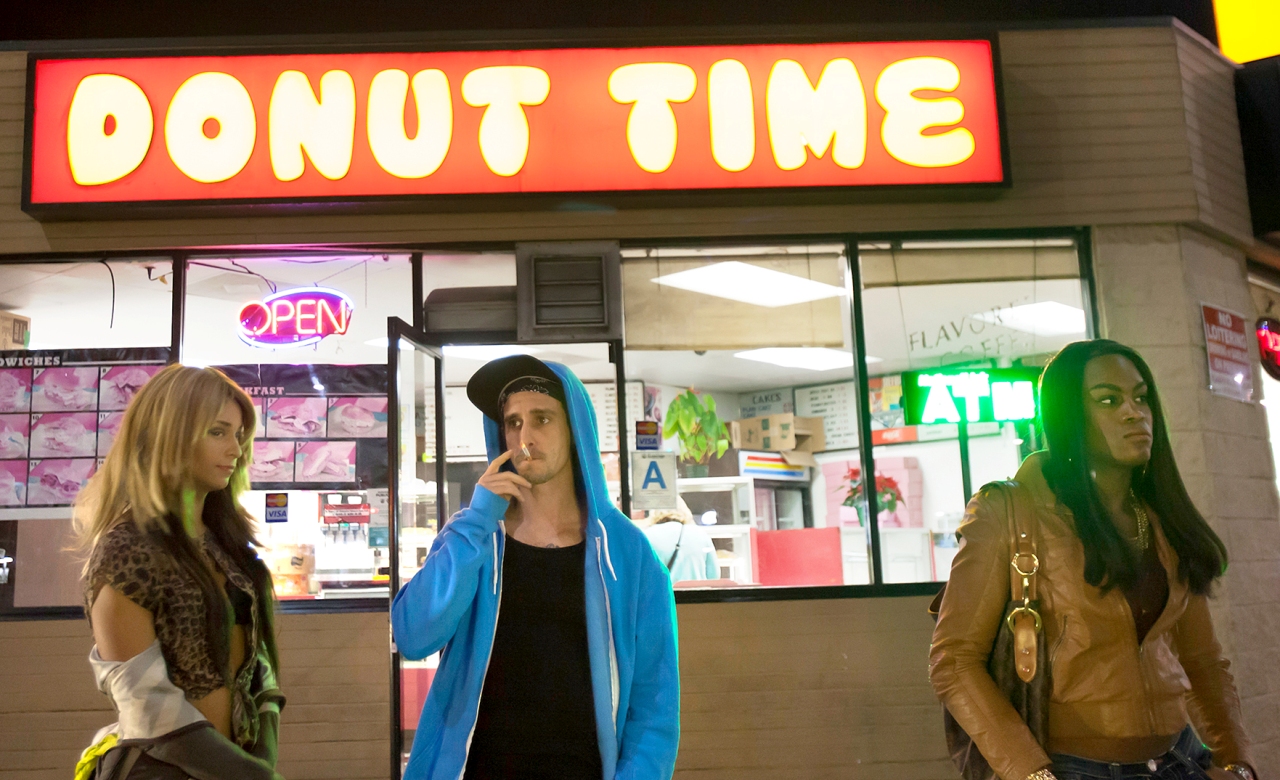The Breakout Transgender Comedy Shot Entirely on an iPhone
Tangerine is an unlikely comedy hit, especially given director Sean Baker's early inspiration was one of Australia's bleakest films.
When you first hear it described to you, Tangerine doesn't exactly scream 'comedy'. Set on the streets of Los Angeles one day before Christmas, the breakout feature at this year's Sundance Film Festival follows a poor transgender sex worker who has just gotten out of prison, only to discover that her pimp/boyfriend has been cheating on her. Sounds pretty grim, right? That's where you'd be wrong.
Working closely with transgender actors Kitana Kiki Rodriguez and Mya Taylor, neither of whom had any prior screen experience, writer-director Sean Baker and his co-writer Chris Bergoch have crafted one of the boldest, funniest and most memorable independent features we've seen in quite some time — one that puts transgender issues front and centre without ever becoming preachy or resorting to cliche.
As if that weren't impressive enough, there's also the story of how they physically made the movie, using little more than a pair of iPhone 5s. Originally a budgetary decision, it ends up being Baker's ace in the hole, lending the film a brash, in-your-face aesthetic that could hardly be more fitting.
We spoke with Baker about what it's like to make a movie on your mobile, as well as the importance of giving narratives like these the spotlight they deserve.
Tell us a little bit about how this project came about?
I live about a half a mile from the intersection of Santa Monica and Highland, which is sort of an unofficial red light district. It's known, especially as of late, for transgender sex workers. That intersection in particular was always known for its drama, and I would pass it and wonder why there haven't been more films that have taken place there.
I was also in a situation where I was trying to get money for a much bigger film, but it never happened. The industry is really upside-down right now, and I was waiting and waiting and waiting, and I knew that if I waited any longer I wasn't ever going to make a film again. So I turned to Mark Duplass and said, "hey, a couple of years ago you offered me a micro-budget. I think I'm in the position where I'm going to have to take it."
So does that mean the decision to shoot on the iPhone was primarily a budgetary one?
Yes. Or at least, it started off that way, and then of course it became an aesthetic.
Were there other films that influenced you, in terms of the way the movie looks?
No, that was the cool part about it — that it seemed to me to be a pretty original aesthetic. We combined a bunch of tools. This anamorphic adapter that we used allowed us to shoot in true scope; true widescreen cinema. Then there was an app called FiLMic Pro that has a bunch of bells and whistles and allows you to shoot at 24 frames per second. And then we used the Smothee, which is a handheld stabiliser that stabilises the iPhone. Then in post production we ended up pumping the colours through the roof, which really enhanced the LA sun. So all of a sudden you have these four tools working together creating this look that I'm really happy with.
When you're on location, what are some of the advantages and/or challenges of shooting on a phone?
What it did was that it allowed us to basically work clandestinely. If you saw us shooting from across the street, you'd never know we were shooting anything professional, except for the fact that we had a boom pole. We got permits, but we didn't have to announce that we were shooting, so we were able to capture real street life. Of course, then we had to ask them for their releases after I yelled 'cut', which is a risk because you then have to chase people down and beg. But for the most part people are pretty nice.
From what we've read elsewhere, it sounds like a lot of research went into the film. How important was it that you immerse yourself in this world?
I think it's the only way. I think it's best to allow the world to speak to you, as opposed to you speaking to a world that you're not a part of. That's just an irresponsible way of storytelling. Chris and I, we're cisgender white males who are not from that world whatsoever. So we needed to do a lot of research. We had to find a collaborator and put the time in. And the collaborators in this case were our leads. Mya especially. She was the first person we met who gave us the enthusiasm we were looking for.
On its face, the film's subject matter sounds fairly grim. Was there ever a version of the script without the comedic elements that played like a more straightforward drama?
It's funny that you mention that, especially with you being from Australia, because the cinema coming out of Australia has been incredibly influential on me. Snowtown is such an amazing masterpiece, and that's what I thought the film was going to be originally. Not the murders, but that social realist style with that really desaturated look.
So then what changed your mind?
Getting to know the women, and hanging out with them regularly, I saw that even though they were dealing with incredible hardships, they used humour to cope. And I knew that the film would be dishonest if I didn't incorporate that humour. It was actually part of Mya's request as well. She said to me point blank, "I've seen your other films and I trust you, and I want to make this movie with you, but you've got to promise me that it will be funny. You've got to make a film that is entertaining for the people out here. We don't want a 'plight of' film that's all drama, hitting people over the head and leaving the audience feeling terrible." And I'm really glad she sent me down that road.
On that point, how has the transgender community reacted to the film?
It's been really positive. I thought this film was going to divide audiences, but so far there's been a really nice amount of love given to us across the board. One of our first reviews from a transperson came from Australia, at the Sydney Film Festival, and she was very, very positive about it. And having travelled with the film a little bit already, I've been able to see how members of trans communities react in different countries. I was in Columbia, in Bogotá, and members of the local trans community came to the premiere, and they said to me afterwards through a translator that while there are lots of cultural differences, they really connected and indentified with the sisterhood between the two main characters, which was a real nice thing to hear.
With television shows like Transparent and Orange Is the New Black, as well as all the recent media coverage surrounding Caitlyn Jenner, it feels as though transgender stories are finally getting attention in mainstream culture. How important is this, and are you pleased to be part of the trend?
Most definitely. Setting down this road two and a half years ago, we had no idea it was going to be as much a part of the zeitgeist as it is now. Any time visibility and awareness is increased it's a positive thing. The unfortunate part of all of this is that the murder rate here in the United State has almost doubled from last year, assuming it stays at this rate. It's hard to get up-to-date statistics because of the fact that a lot of these murders aren't investigated correctly. But we're already up to 15 murders of transpeople here in the United States in 2015, and we're only at the end of August. The hope is that increased awareness and visibility will eventually lead to acceptance, but we still have a long way to go.
I also think we need a number of these types of narratives. I'm making a film about a microcosm — about transwomen of colour who happen to work as sex workers in a very small area of Los Angeles. So this is only representative of a tiny, tiny portion of the transgender community. This has to be one of many, many different narratives that are being told.
Tangerine is in cinemas in Sydney and Melbourne now.








